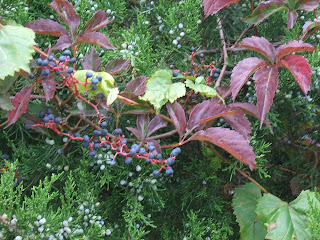








Whatever holidays you celebrate, you can make them more sustainable. You can save energy by decorating with fewer lights this year, and try to make your purchases organic, all natural, local or fair trade or recycled. Remember to reduce, reuse and recycle, too!
Look for farms and stores in this area that sell locally-produced, sometimes organic, grass-fed or free range meat and poultry. There may even be fresh local vegetables, too. Kale and collards are alive in our garden (along with leeks and parsnips), undamaged by frost and snow (see first two photos). Some say freezing makes the flavor sweeter. Winter squash will keep for the whole winter in a cool place, and I already invented a recipe for some of those extra pumpkins we didn't use for Halloween. I took pumpkin/tomato/rice casserole to a holiday potluck before a dance, and it was well-received.
You could buy a locally grown Christmas tree and support a local farmer and local open space. You could also prune your evergreen trees and shrubs right now and use the trimmings for decorations on your door or porch instead of paying for the electricity for a lot of lights.
Have you ever heard of Fair Trade? It is a category of goods that are made by people who need jobs, who are paid a decent wage for making them. There are charitable and religious organizations that produce or certify food, gifts, clothing etc. as fair trade. The items come from Asia, Africa, Europe, North or South America, from farmers and craftspeople. Here in the USA some fair trade items are produced in inner cities and some by native Americans. Often the organization provides loans, sponsors cooperative production facilities, bypasses exploitative middlemen, or teaches marketable skills. Sometimes they build a clinic, a school or sanitation facilities, or teach classes. To be certified fair trade, a product must use materials that are sustainably harvested.
There are plenty of fair trade items available: gifts; holiday treats; and holiday decorations. You can find them in some local shops, in catalogs and on the internet.
You may also give the gift of a charitable contribution, or buy holiday greeting cards from a charity.
One of my favorite ways to reduce waste for the holidays is to make gift bags (third photo). I sewed them from fabric scraps from my own sewing or found at rummage sales. Mostly I use them for gifts for my own family, because I know we will reuse them next year. They make the holiday gift wrapping go very fast.
To make your own gift bags, you should know how to sew. Start with a square of fabric, not too thick or see-through. Fold the square in half into a rectangle, with the right side of the fabric inside and the wrong side outside. The rectangle should have one edge folded and the other three will be cut edges. Sew an L-shaped seam joining back and front along two of the cut edges (fourth photo). This should make a bag, but it is not yet a gift bag. Before you turn it right-side out, you will have to clip the seam allowance (see fifth photo). Be careful not to cut the stitching. Turn the bag right-side out, and hem the remaining edge of the bag, preferably turning it under twice. Now take a cloth ribbon or cord, and sew it by its middle to the outside of the bag, on the seam, an inch or two from the hem (sixth photo). Now your gift bag is ready. Put a gift inside, scrunch up the top of the bag and tie the ribbon around it in a bow (seventh photo) .
You may make bags in many shapes and sizes, but they should always be deeper than they are wide (eighth photo). If you are lucky, you can find a piece of fabric with selvedge, the woven edge of the fabric that won't ravel, and use that for the edge of the bag so you don't have to hem. While you are sewing the seam, you may insert the ribbon or cord, and save yourself sewing it on later. If the ribbon or cord is narrow enough you may add a gift tag. If the ribbon or cord is too wide, you might like to add another ribbon, shorter and narrower, to tie the gift tag (ninth photo).
Remember to donate to the food pantry for those people who are out of work or otherwise in need, and don't forget to recycle and compost.
Have happy and sustainable holidays!

















































+for+webpage+display.jpg)